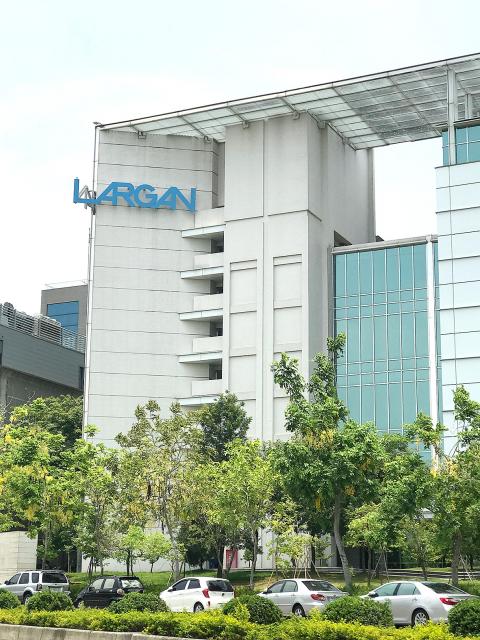Largan Precision Co (大立光) yesterday reported double-digit percentage growth in revenue for last month, reaching its highest level in eight months, a sign that the smartphone camera lens supplier is making progress ramping up production as the industry enters its peak season and customers launch new models.
Consolidated revenue for last month reached NT$5.33 billion (US$173.6 million) last month, up 18.2 percent from the previous month and 19.57 percent from a year earlier, figures on Largan’s Web site showed.
Last month’s figures were the highest since November last year, when the company posted NT$5.61 billion in revenue, the company’s data showed.

Photo: Chen Mei-ying, Taipei Times
High-margin lenses for cameras of 20 or more megapixels accounted for 10 to 20 percent of its total shipments last month, lenses for products of 10 megapixels and above contributed 60 to 70 percent, lenses for 8-megapixel products made up 10 to 20 percent and other lenses for products with lower resolutions contributed 10 to 20 percent, Largan’s shipment breakdown showed.
As a leading maker of optical lens modules, Largan also produces real-image viewfinders and other optoelectronic parts.
With May and June sales returning to positive annual growth, last month’s numbers further confirmed that the Taichung-based company remains a solid player in Apple Inc’s supply chain, while its effort to re-engage with Android smartphone vendors has been fruitful.
Even so, the company’s cumulative revenue for the first seven months of the year was still 0.28 percent lower than the same period last year, totaling NT$26.5 billion.
Largan began shipping lenses for dual-camera iPhone models in June and the momentum should continue into this quarter, supported by the company’s July 12 revenue guidance of sequential gains for this month and next month, analysts said.
In research notes released on July 13, Maybank Kim Eng Securities Ltd said the key drivers to Largan’s revenue growth include rising prices for iPhone lenses and market share gains in Android phones, while Credit Suisse Group AG said the company’s revenue for this quarter would grow 30 percent from last quarter’s NT$12.3 billion.
Thanks to a better revenue scale, a more favorable product mix and a continued improvement in production yield rates, Largan shares have risen 27.61 percent so far this year. The stock closed at NT$5,130 on Friday in Taipei trading, Taiwan Stock Exchange data showed.

Zhang Yazhou was sitting in the passenger seat of her Tesla Model 3 when she said she heard her father’s panicked voice: The brakes do not work. Approaching a red light, her father swerved around two cars before plowing into a sport utility vehicle and a sedan, and crashing into a large concrete barrier. Stunned, Zhang gazed at the deflating airbag in front of her. She could never have imagined what was to come: Tesla Inc sued her for defamation for complaining publicly about the vehicles brakes — and won. A Chinese court ordered Zhang to pay more than US$23,000 in

Taiwan Semiconductor Manufacturing Co (TSMC, 台積電) yesterday said that its investment plan in Arizona is going according to schedule, following a local media report claiming that the company is planning to break ground on its third wafer fab in the US in June. In a statement, TSMC said it does not comment on market speculation, but that its investments in Arizona are proceeding well. TSMC is investing more than US$65 billion in Arizona to build three advanced wafer fabs. The first one has started production using the 4-nanometer (nm) process, while the second one would start mass production using the

US President Donald Trump has threatened to impose up to 100 percent tariffs on Taiwan’s semiconductor exports to the US to encourage chip manufacturers to move their production facilities to the US, but experts are questioning his strategy, warning it could harm industries on both sides. “I’m very confused and surprised that the Trump administration would try and do this,” Bob O’Donnell, chief analyst and founder of TECHnalysis Research in California, said in an interview with the Central News Agency on Wednesday. “It seems to reflect the fact that they don’t understand how the semiconductor industry really works,” O’Donnell said. Economic sanctions would

‘NO DISRUPTION’: A US trade association said that it was ready to work with the US administration to streamline the program’s requirements and achieve shared goals The White House is seeking to renegotiate US CHIPS and Science Act awards and has signaled delays to some upcoming semiconductor disbursements, two sources familiar with the matter told reporters. The people, along with a third source, said that the new US administration is reviewing the projects awarded under the 2022 law, meant to boost US domestic semiconductor output with US$39 billion in subsidies. Washington plans to renegotiate some of the deals after assessing and changing current requirements, the sources said. The extent of the possible changes and how they would affect agreements already finalized was not immediately clear. It was not known